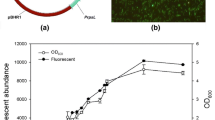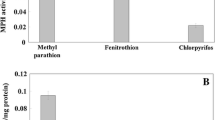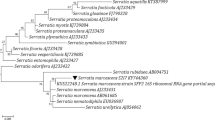Abstract
Polychlorobiphenyls (PCBs) are classified as “high-priority pollutants.” Diverse microorganisms are able to degrade PCBs. However, bacterial degradation of PCBs is generally incomplete, leading to the accumulation of chlorobenzoates (CBAs) as dead-end metabolites. To obtain a microorganism able to mineralize PCB congeners, the bph locus of Burkholderia xenovorans LB400, which encodes one of the most effective PCB degradation pathways, was incorporated into the genome of the CBA-degrading bacterium Cupriavidus necator JMP134-X3. The bph genes were transferred into strain JMP134-X3, using the mini-Tn5 transposon system and biparental mating. The genetically modified derivative, C. necator strain JMS34, had only one chromosomal insertion of bph locus, which was stable under nonselective conditions. This modified bacterium was able to grow on biphenyl, 3-CBA and 4-CBA, and degraded 3,5-CBA in the presence of m-toluate. The strain JMS34 mineralized 3-CB, 4-CB, 2,4′-CB, and 3,5-CB, without accumulation of CBAs. Bioaugmentation of PCB-polluted soils with C. necator strain JMS34 and with the native B. xenovorans LB400 was monitored. It is noteworthy that strain JMS34 degraded, in 1 week, 99% of 3-CB and 4-CB and approximately 80% of 2,4′-CB in nonsterile soil, as well as in sterile soil. Additionally, the bacterial count of strain JMS34 increased by almost two orders of magnitude in PCB-polluted nonsterile soil. In contrast, the presence of native microflora reduced the degradation of these PCBs by strain LB400 from 73% (sterile soil) to approximately 50% (nonsterile soil). This study contributes to the development of improved biocatalysts for remediation of PCB-contaminated environments.






Similar content being viewed by others
References
Adams RH, Huang CM, Higson FK, Brenner V, Focht DD (1992) Construction of a 3-chlorobiphenyl-utilizing recombinant from an intergeneric mating. Appl Environ Microbiol 58:647–654
Agulló L, Cámara B, Martínez P, Latorre-Reyes V, Seeger M (2007) Response to (chloro)biphenyls of the PCB-degrader Burkholderia xenovorans LB400 involves stress proteins induced also by heat shock and oxidative stress. FEMS Microbiol Lett 267:167–175
Arensdorf JJ, Focht DD (1994) Formation of chlorocatechol meta cleavage products by a Pseudomonad during metabolism of monochlorobiphenyls. Appl Environ Microbiol 60:2884–2889
Bartels I, Knackmuss H-J, Reineke W (1984) Suicide inactivation of catechol 2, 3-dioxygenase from Pseudomonas putida mt-2 by 3-halocatechols. Appl Environ Microbiol 47:500–505
Bedard DL, Haberl ML (1990) Influence of chlorine substitution pattern on the degradation of polychlorinated biphenyls by eight bacterial strains. Microb Ecol 20:87–102
Blasco R, Wittich RM, Mallavarapu M, Timmis KN, Pieper DH (1995) From xenobiotic to antibiotic, formation of protoanemonin from 4-chlorocatechol by enzymes of the 3-oxoadipate pathway. J Biol Chem 270:29229–29235
Blasco R, Mallavarapu M, Wittich RM, Timmis KN, Pieper DH (1997) Evidence that formation of protoanemonin from metabolites of 4-chlorobiphenyl degradation negatively affects the survival of 4-chlorobiphenyl-cometabolizing microorganisms. Appl Environ Microbiol 63:427–434
Brenner V, Rucka L, Totevova S, Tomeraas K, Demnerova K (2004) Efficiency of chlorocatechol metabolism in natural and constructed chlorobenzoate and chlorobiphenyl degraders. J Appl Microbiol 96:430–436
Cámara B, Herrera C, González M, Couve E, Hofer B, Seeger M (2004) From PCBs to highly toxic metabolites by the biphenyl pathway. Environ Microbiol 6:842–850
Chain PS, Denef VJ, Konstantinidis KT, Vergez LM, Agulló L, Latorre-Reyes V, Hauser L, Córdova M, Gómez L, González M, Land M, Lao V, Larimer F, LiPuma JJ, Mahenthiralingam E, Malfatti SA, Marx CJ, Parnell JJ, Ramette A, Richardson P, Seeger M, Smith D, Spilker T, Sul WJ, Tsoi TV, Ulrich LE, Zhulin IB, Tiedje JM (2006) Burkholderia xenovorans LB400 harbors a multi-replicon, 9.73-Mbp genome shaped for versatility. Proc Natl Acad Sci USA 103:15280–15287
Cowles CE, Nichols NN, Harwood CS (2000) BenR, a XylS homologue, regulates three different pathways of aromatic acid degradation in Pseudomonas putida. J Bacteriol 182:6339–6346
de Lorenzo V, Fernandez S, Herrero M, Jakubzik U, Timmis KN (1993) Engineering of alkyl- and haloaromatic-responsive gene expression with mini-transposons containing regulated promoters of biodegradative pathways of Pseudomonas. Gene 130:41–46
Don RH, Pemberton JM (1981) Properties of six pesticide degradation plasmids isolated from Alcaligenes paradoxus and Alcaligenes eutrophus. J Bacteriol 145:681–686
Florence TM, Farrar YJ (1971) Spectrophotometric determination of chloride at the parts-per-billion level by the mercury (II) thiocyanate method. Anal Chim Acta 54:373–377
Furukawa K, Chakrabarty AM (1982) Involvement of plasmids in total degradation of polychlorinated biphenyls. Appl Environ Microbiol 44:619–626
Furukawa K, Fujihara H (2008) Microbial degradation of polychlorinated biphenyls: biochemical and molecular features. J Biosci Bioeng 105:433–449
Greated A, Lambertsen L, Williams PA, Thomas CM (2002) Complete sequence of the IncP-9 TOL plasmid pWW0 from Pseudomonas putida. Environ Microbiol 4:856–871
Haddock JD, Horton JR, Gibson DT (1995) Dihydroxylation and dechlorination of chlorinated biphenyls by purified biphenyl 2, 3-dioxygenase from Pseudomonas sp. strain LB400. J Bacteriol 177:20–26
Havel J, Reineke W (1992) Degradation of Aroclor and survival of strains in soil microcosms. Appl Environ Microbiol 38:129–134
Herrero M, de Lorenzo V, Timmis KN (1990) Transposon vectors containing non-antibiotic resistance selection markers for cloning and stable chromosomal insertion of foreign genes in Gram-negative bacteria. J Bacteriol 172:6557–6567
Hofer B, Eltis LD, Dowling DN, Timmis KN (1993) Genetic analysis of a Pseudomonas locus encoding a pathway for biphenyl/polychlorinated biphenyl degradation. Gene 130:47–55
Hofer B, Blasco R, Mallavarapu M, Seeger M, McKay D, Wittich R, Pieper DH, Timmis KN (1996) Pseudomonads designed for bioremediation and circumvention of undesirable routes. In: Nakazawa T (ed) Molecular biology of pseudomonads. ASM, Washington DC, pp 121–131
Jeffrey WH, Cuskey SM, Chapman PJ, Resnick S, Olsen RH (1992) Characterization of Pseudomonas putida mutants unable to catabolize benzoate: cloning and characterization of Pseudomonas genes involved in benzoate catabolism and isolation of a chromosomal DNA fragment able to substitute for xylS in activation of the TOL lower-pathway promoter. J Bacteriol 174:4986–4996
Kröckel L, Focht DD (1987) Construction of chlorobenzene-utilizing recombinants by progenitive manifestation of a rare event. Appl Environ Microbiol 53:2470–2475
Laemmli C, Werlen C, van der Meer JR (2004) Mutation analysis of the different tfd genes for degradation of chloroaromatic compounds in Ralstonia eutropha JMP134. Arch Microbiol 181:112–121
Ledger T, Pieper DH, Pérez-Pantoja D, González B (2002) Novel insights into the interplay between peripheral reactions encoded by xyl genes and the chlorocatechol pathway encoded by tfd genes for the degradation of chlorobenzoates by Ralstonia eutropha JMP 134. Microbiology 148:3431–3440
Leigh MB, Prouzova P, Mackova M, Macek T, Nagle DP, Fletcher JS (2006) Polychlorinated biphenyl (PCB)-degrading bacteria associated with trees in a PCB-contaminated site. Appl Environ Microbiol 72:2331–2342
Martínez P, Agulló L, Hernández M, Seeger M (2007) Chlorobenzoate inhibits growth and induces stress proteins in the PCB-degrading strain Burkholderia xenovorans LB400. Arch Microbiol 188:289–297
McLeod MP, Warren RL, Hsiao WW, Araki N, Myhre M, Fernandes C, Miyazawa D, Wong W, Lillquist AL, Wang D, Dosanjh M, Hara H, Petrescu A, Morin RD, Yang G, Stott JM, Schein JE, Shin H, Smailus D, Siddiqui AS, Marra MA, Jones SJ, Holt R, Brinkman FS, Miyauchi K, Fukuda M, Davies JE, Mohn WW, Eltis LD (2006) The complete genome of Rhodococcus sp. RHA1 provides insights into a catabolic powerhouse. Proc Natl Acad Sci USA 103:15582–15587
Morgante V, López-López A, Flores C, González M, González B, Vásquez M, Rosselló-Mora R, Seeger M (2010) Bioaugmentation with Pseudomonas sp. strain MHP41 promotes simazine attenuation and bacterial community changes in agricultural soils. FEMS Microbiol Ecol 71:114–126
Mukerjee-Dhar G, Shimura M, Miyazawa D, Kimbara K, Hatta T (2005) bph genes of the thermophilic PCB degrader, Bacillus sp. JF8: characterization of the divergent ring-hydroxylating dioxygenase and hydrolase genes upstream of the Mn-dependent BphC. Microbiol 151:4139–4151
Ohtsubo Y, Kudo T, Tsuda M, Nagata Y (2004) Strategies for bioremediation of polychlorinated biphenyls. Appl Microbiol Biotechnol 65:250–258
Orvos DR, Lacy GH, Cairns J (1990) Genetically engineered Erwinia carotovora: survival, intraspecific competition, and effects upon selected bacterial genera. Appl Environ Microbiol 56:1689–1694
Palma-Fleming H, Cornejo C, González M, Pérez V, González M, Gutierrez E, Sericano JL, Seeger M (2008) Polycyclic aromatic hydrocarbons and polychlorinated biphenyls from the coastal reef of Valdivia and Valparaíso regions, Chile. J Chil Chem Soc 53:1393–1398
Pérez-Pantoja D, Guzman L, Manzano M, Pieper DH, González B (2000) Role of tfdC(I)D(I)E(I)F(I) and tfdD(II)C(II)E(II)F(II) gene modules in catabolism of 3-chlorobenzoate by Ralstonia eutropha JMP134(pJP4). Appl Environ Microbiol 66:1602–1608
Pérez-Pantoja D, Ledger T, Pieper DH, González B (2003) Efficient turnover of chlorocatechols is essential for growth of Ralstonia eutropha JMP134(pJP4) in 3-chlorobenzoic acid. J Bacteriol 185:1534–1542
Pérez-Pantoja D, De la Iglesia R, Pieper DH, González B (2008) Metabolic reconstruction of aromatic compounds degradation from the genome of the amazing pollutant-degrading bacterium Cupriavidus necator JMP134. FEMS Microbiol Rev 32:736–794
Pieper D, Seeger M (2008) Bacterial metabolism of polychlorinated biphenyls. J Mol Microbiol Biotechnol 15:121–138
Ramos JL, Stolz A, Reineke W, Timmis KN (1986) Altered effector specificities in regulators of gene expression: TOL plasmid xylS mutants and their use to engineer expansion of the range of aromatics degraded by bacteria. Proc Natl Acad Sci USA 83:8467–8471
Reineke W, Jeenes DJ, Williams PA, Knackmuss HJ (1982) TOL plasmid pWW0 in constructed halobenzoate-degrading Pseudomonas strains: prevention of meta pathway. J Bacteriol 150:195–201
Rodrigues J, Kachel A, Aiello M, Quensen J, Maltseva O, Tsoi T, Tiedje JM (2006) Degradation of Aroclor 1242 dechlorination products in sediments by Burkholderia xenovorans LB400(ohb) and Rhodococcus sp. strain RHA1(fcb). Appl Environ Microbiol 72:2476–2482
Sambrook J, Fritsch EF, Maniatis T (1989) Molecular cloning. A laboratory manual, 2nd edn. Cold Spring Harbor Laboratory Press, Cold Spring Harbor
Sánchez-Romero JM, Diaz-Orejas R, de Lorenzo V (1998) Resistance to tellurite as a selection marker for genetic manipulations of Pseudomonas strains. Appl Environ Microbiol 64:4040–4046
Seah S, Labbé G, Nerdinger S, Johnson MR, Snieckus V, Eltis LD (2000) Identification of a serine hydrolase as a key determinant in the microbial degradation of polychlorinated biphenyls. J Biol Chem 275:15701–15708
Seeger M, Pieper D (2009) Genetics of biphenyl biodegradation and co-metabolism of PCBs. In: Timmis KN (ed) Microbiology of hydrocarbons, oils, lipids, and derived compounds, vol. 2. Springer, Heidelberg, pp 1179–1199
Seeger M, Timmis KN, Hofer B (1995a) Degradation of chlorobiphenyls catalyzed by the bph-encoded biphenyl-2, 3-dioxygenase and biphenyl-2,3-dihydrodiol-2,3-dehydrogenase of Pseudomonas sp. LB400. FEMS Microbiol Lett 133:259–264
Seeger M, Timmis KN, Hofer B (1995b) Conversion of chlorobiphenyls into phenylhexadienoates and benzoates by the enzymes of the upper pathway for polychlorobiphenyl degradation encoded by the bph locus of Pseudomonas sp. strain LB400. Appl Environ Microbiol 61:2654–2658
Seeger M, Timmis KN, Hofer B (1997) Bacterial pathways for the degradation of polychlorinated biphenyls. Mar Chem 58:327–333
Seeger M, Zielinski M, Timmis KN, Hofer B (1999) Regiospecificity of dioxygenation of di-to pentachlorobiphenyls and their degradation to chlorobenzoates by the bph-encoded catabolic pathway of Burkholderia sp. strain LB400. Appl Environ Microbiol 65:3614–3621
Seeger M, Cámara B, Hofer B (2001) Dehalogenation, denitration, dehydroxylation, and angular attack on substituted biphenyls and related compounds by a biphenyl dioxygenase. J Bacteriol 183:3548–3555
Seeger M, González M, Cámara B, Muñoz L, Ponce E, Mejías L, Mascayano C, Vásquez Y, Sepúlveda-Boza S (2003) Biotransformation of natural and synthetic isoflavonoids by two recombinant microbial enzymes. Appl Environ Microbiol 69:5045–5050
Sierra I, Valera JL, Marina ML, Laborda F (2003) Study of the biodegradation process of polychlorinated biphenyls in liquid medium and soil by a new isolated aerobic bacterium (Janibacter sp.). Chemosphere 53:609–618
Skiba A, Hecht V, Pieper DH (2002) Formation of protoanemonin from 2-chloro-cis,cis-muconate by the combined action of muconate cycloisomerase and muconolactone isomerase. J Bacteriol 184:5402–5409
Sondossi M, Sylvestre M, Ahmad D (1992) Effects of chlorobenzoate transformation on the Pseudomonas testosteroni biphenyl and chlorobiphenyl degradation pathway. Appl Environ Microbiol 58:485–495
Stratford J, Wright MA, Reineke W, Mokross H, Havel J, Knowles CJ, Robinson GR (1996) Influence of chlorobenzoates on the utilisation of chlorobiphenyls and chlorobenzoate mixtures by chlorobiphenyl/chlorobenzoate mineralizing hybrid bacterial strains. Arch Microbiol 165:213–218
Trefault N, Clement P, Manzano M, Pieper DH, González B (2002) The copy number of the catabolic plasmid pJP4 affects growth of Ralstonia eutropha JMP134 (pJP4) on 3-chlorobenzoate. FEMS Microbiol Lett 212:95–100
Trefault N, de la Iglesia R, Molina AM, Manzano M, Ledger T, Pérez-Pantoja D, Sánchez MA, Stuardo M, González B (2004) Genetic organization of the catabolic plasmid pJP4 from Ralstonia eutropha JMP134 (pJP4) reveals mechanisms of adaptation to chloroaromatic pollutants and evolution of specialized chloroaromatic degradation pathways. Environ Microbiol 6:655–668
Vaillancourt FH, Labbe G, Drouin NM, Fortin PD, Eltis LD (2002) The mechanism-based inactivation of 2,3-dihydroxybiphenyl 1,2-dioxygenase by catecholic substrates. J Biol Chem 277:2019–2027
Vrana B, Decorová K, Baláz S, Sevciková A (1996) Effect of chlorobenzoates on the degradation of polychlorinated biphenyls (PCB) by Pseudomonas stutzeri. J Microbiol Biotechnol 12:323–326
Wittich R, Wolff P (2007) Growth of the genetically engineered strain Cupriavidus necator RW112 with chlorobenzoates and technical chlorobiphenyls. Microbiol 153:186–195
Zanaroli G, Fedi S, Carnevali M, Fava F, Zannoni D (2002) Use of potassium tellurite for testing the survival and viability of Pseudomonas pseudoalcaligenes KF707 in soil microcosms contaminated with polychlorinated biphenyls. Res Microbiol 153:353–360
Acknowledgements
The authors thank Bernardo González, Thomas Ledger, Víctor de Lorenzo, Bernd Hofer, and Edward Moore for support and helpful discussions. M.S. gratefully acknowledges support from the grants FONDECYT 1070507, 7090079, and 1020221, USM 130522, 130836, and 130948, MILENIO P04/007-F (MIDEPLAN), and CONICYT-BMBF.
Author information
Authors and Affiliations
Corresponding author
Rights and permissions
About this article
Cite this article
Saavedra, J.M., Acevedo, F., González, M. et al. Mineralization of PCBs by the genetically modified strain Cupriavidus necator JMS34 and its application for bioremediation of PCBs in soil. Appl Microbiol Biotechnol 87, 1543–1554 (2010). https://doi.org/10.1007/s00253-010-2575-6
Received:
Revised:
Accepted:
Published:
Issue Date:
DOI: https://doi.org/10.1007/s00253-010-2575-6




